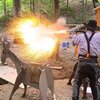DJ,
I asked about outside of competition.
Your reply doesn't address the real world and whether the Howell .22 Colt cylinder slots are safe for public carry, or the Remington cylinder slots.
There isn't such a safety rule for public carry, is there?
I wouldn't know. I don't carry.
If I did carry a Colt, it would be loaded with five rounds, with the hammer down on an empty chamber. Why do you think Ruger started using transfer bars back in the 1970s? Too many lawsuits from injuries resulting in shooters who did not understand that an old Colt, or a Ruger Three Screw for that matter, could discharge if it fell to the ground and landed on its hammer. If I carried a modern Ruger, it would be fully loaded as would any relatively modern S&W revolver that I own.
For what it's worth, the nose of the hammer on my old EuroArms Remmie is too fat to slip into the slots between firing pins on my old R&D cylinder, so I would not consider carrying it without an empty chamber under the hammer. Yeah, I could file down the hammer nose to make it fit, but I ain't gonna do that.

The pins between nipples on the Pietta 1860 at the left in this photo are far too small to be relied on to keep the hammer there.

The Smith and Wesson New Model Number Three actually had a rebounding hammer and the trigger sear would pop into a tiny 'safety notch' on the hammer when the trigger was released. Look how tiny those parts are, they surely would not survive if the gun fell on its hammer spur, so I would never carry one of these fully loaded.

As with most of the other #3 Top Breaks, the Russian model did not have a rebounding hammer. Just a simple 'safety cock' notch on the hammer that would probably break if the hammer spur received a strong blow.

And forget about keeping the firing pin between rims on a fully loaded Colt. At least with large calibers, there is not enough space between rims to keep the rounded tip of the firing pin from riding up over the rims if the cylinder gets rotated.

P.S. I should post this photo of Colt parts. the upper arrow is pointing to the 'safety cock' notch on the hammer, the lower arrow is pointing to the sear. The sear is very thin. If it was nested in the 'safety cock' notch of the hammer and the hammer spur received a serious blow, the sear would probably shear right off.

Lock parts if a Colt Bisley. The sear is just as delicate as the sear on the standard SAA.

















